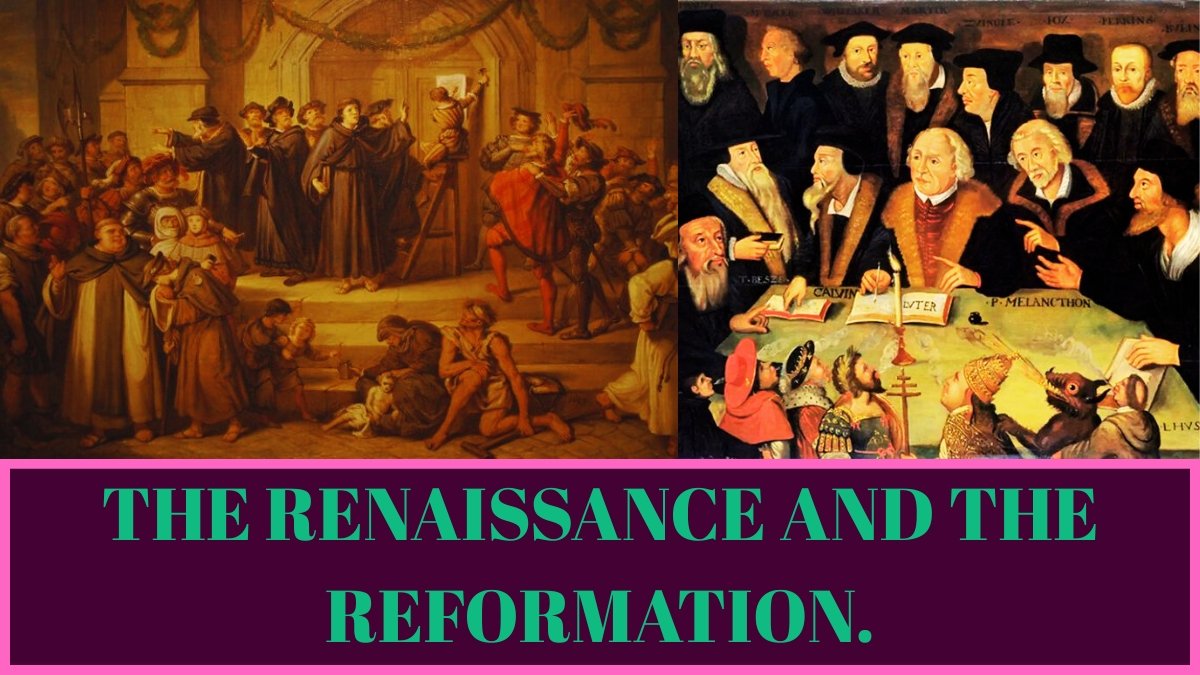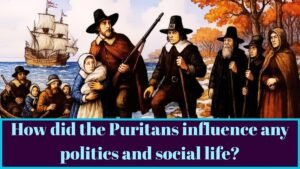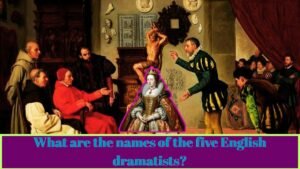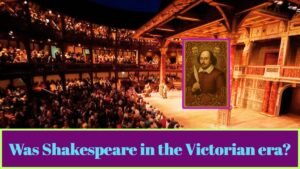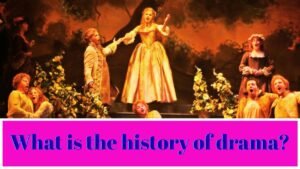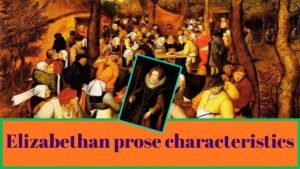THE RENAISSANCE AND THE REFORMATION.
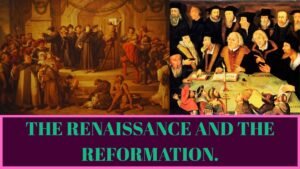
THE RENAISSANCE AND THE REFORMATION:Sovereigns-Henry VII 1485-1509, Henry VIII 1509-1547, Edward VI 1547-1553, Mary 1553-1558, Elizabeth 1558-1603.
The meaning of Renaissance-Its beginning in Italy with Petrarch and Boccacio in the 14th Century-The discovery of classical Latin literature of Virgil, Ovid, and Cicero-The capture of Constantinople, the last stronghold of Greek culture by the Turks, and the flight of Greek scholars Westward-Their welcome in Italy and the spread of ‘humanism’-Assisted by the inven-tion of printing in Germany, and later by the discovery of America-Reforma-tion: Its beginning in Germany with Martin Luther’s revolt against the Pope-The split in the Christian Church into Protestant and Catholic-Reformation in England: Henry VIII’s divorce of Anne Boleyn and his break with the Pope led to his becoming independent head of the English Church-Reformation furthered under Edward VI, checked under ‘bloody’ Mary, and restored under Elizabeth-Renaissance late in England-Its advance under Henry VIII and climax under Elizabeth.
What is the meaning of the Renaissance?
The end of the fifteenth century marks the end of the Middle Ages. We now enter upon a new era-that of the Renaissance. Before considering the literature of Renaissance England, we must first try to understand the new tendencies in the life and thought of the English people that the Renaissance brought in.
THE RENAISSANCE
The word Renaissance means rebirth (Re: again, naissance: birth). Who was reborn? It was the human spirit that was reborn or awakened after the long slumber of the Middle Ages. This rebirth or awakening was brought about by a revival of interest in the culture and civilisation of ancient Greece and Rome. The study of classical Greek and Roman art and literature came to be called Humanism and its devotees Humanists. Humanism simply means the religion of humanity or devotion to human or secular interests, as opposed to divinity. As divinity or dogmatic religion had been the chief concern in the Middle Ages, the new learning of humanism brought about a revolutionary change in the life and outlook of the people in that it was a change of emphasis from the religious to the secular. From now on, people began to value life for its own sake and not merely as a preparation ground for that in the next world. This secular spirit marked the end of the Middle Ages and the beginning of a new epoch-the age of Renaissance.
Italy was the home of the Renaissance. Dante (1265-1321) is the last representative of the Middle Ages. In his Divine Comedy he roams through heaven and hell and purgatory. The poet who came after him, Petrarch (1304-74) changed all that. He turned away from such uch gloomy subjects and wrote of more agreeable things of love, of nature, and of the glories of ancient Rome. The people were delighted and they crowned him with the laurel wreath of the poet laureate. He was soon joined by his young friend Boccacio (1313-75) who delighted his countrymen with rollicking stories of love and laughter and poems of romance and passion.
What was the Renaissance period 1500 to 1600?
Both these Italians were immensely interested in the past achieve-ments of their country, the relics of ancient buildings, the beautiful statues and vases dug up here and there, the old and forgotten manuscripts of Virgil, Ovid or Cicero fished out from some musty library. These reminded them of the mighty Roman Empire that had ruled the world a thousand years. So Petrarch and Boccacio were among the earliest of the humanists and their work marks the dawn of the Renaissance. The Italians were thrilled with the newly discovered beauties of ancient Rome. Soon the craze spread to western Europe. The scholar who studied the Roman antiquities, art and literature became a highly respected figure.
In the midst of this intellectual revolution, an event took place which gave a further fillip to the new scholarship. The Turks who were firmly established in Asia Minor, Syria, and and Egypt and had extended their conquests to the eastern Mediterranean, Greece and the Balkans, even to the gates of Vienna, were now pressing hard on Constantinople, the capital of the Byzantine or the eastern half of the original Roman Empire. In 1453, this last stronghold of Greek culture fell to the Turks. Long before this the Greek scholars alarmed by the Turkish pressure had been fleeing West along with their precious libraries. They had found welcome in Italy, parti-cularly in Florence under the patronage of the great family of Medici who ruled there. With the fall of Constantinople, the flow of Greek scholars became a steady stream. The Italians who had only heard of the great names of Homer, of Plato and Aristotle, and were anxious to know them at first hand, now satisfied their curiosity at the feet of the refugee scholars. Their joy knew no bounds. To the treasure of ancient Rome was added the new and richer treasure of ancient Greece that had been the nurse of ancient Rome. The universities were alarmed, for the students flocked round the Greek scholars, the humanists, leaving their own teachers, the schoolmen, who were still teaching the antiquated scholastic philosophy, an abstruse mixture of the Bible and Aristotle’s logic filtered through Arabic scholars. The schoolmen fought against the new learning in vain. A last stand was made in Florence, the centre of the renaissance, by the monk Savanarola, who denounced the artistic licence and craze for beauty that had seized the people. As a result of his frenzied eloquence, the people were frightened and promised to repent for their sinful love of beauty and pleasure. They made a bonfire of their books, statues, and paintings, to the great satisfaction of the fanatic. His joy, however, was short-lived; for the people realizing what they had done in a moment of weak-ness, turned against him. He was dragged through the streets, hanged and burnt. Nobody could save him, not even the Pope, for Popes themselves had turned humanists, filling the Vatican with the most precious treasures of Greek and Roman art. The renais-sance was in full tide in Italy at the end of the 15th century and marked the end of the Middle Ages. Excluding the era of classical Latin, the Renaissance is the most glorious period of Italy in art and literature. In literature the most famous productions were: in poetry (1) Ariosto’s Orlande Furioso, a romantic poem and (2) Tasso’s Jerusalem Delivered a romantic epic; in Prose: Castiglione’s The Courtier, presenting ‘the Renaissance ideal of living as a fine art’, the Autobiography of Benvenuto Cellini, the famous sculptor and lover, Machiavelli’s The Prince, a book of political philosophy which has given us the word ‘Machiavellian’ meaning unscrupulous, Bandello’s Tales and Cinthio’s Hundred Tales (or Hecatommithi). In the sphere of art Italian artists, more particularly Italian painters
of Renaissance, remain supreme to this day. The most famous are: (1) Leonardo da Vinci, painter, sculptor and engineer-the most gifted of all.
(2) Michaelangelo, painter and sculptor, famous, among other things, for his frescoes of the Sistine Chapel in the Vatican.
(3) Raphael, painter, famous specially for the Madonnas.
(4) Andrea del Sarto, painter, celebrated in Browning’s poem of that name.
(5) Correggio, painter
(6) Tintoretto, painter, glorified by Ruskin in his Modern Painters.
While the fall of Constantinople was the most important event in producing and spreading the spirit of humanism, there were other events and influences which contributed to the new awakening of the Renaissance. About the middle of the 15th century, Johann Gutenberg of Germany invented printing. This led to the multi-plication of books which could now be acquired easily and cheaply. There was a general increase in the number of readers and in the thirst for knowledge. And knowledge meant broad-mindedness, freedom from prejudice, individualism and free thinking.
As a climax to this intellectual ferment came the discovery of America by Columbus in 1492. This further widened the people’s mental horizon and fired their imagination. Other discoveries followed, which revealed a world of new and unheard-of riches. The vision of a new world with abundant riches to be acquired by the ambitious filled the people with a spirit of adventure. Adven-turers like John Hawkins and Francis Drake who were traders as well as pirates on the high seas brought immense treasure to Eng-land in the reign of Elizabeth.
The spirit of inquiry and free thinking fostered by the new learning and the new discoveries led to scientific theories in various fields. Of these the astronomical theories of Copernicus (1473-1543), Galileo (1564-1642), and Kepler (1571-1630) had the effect of changing entirely the medieval conception of the universe and of man’s place in it.
THE REFORMATION
The most notable result of the Renaissance in the sphere of religion was the revolution known as the Reformation. The questioning spirit engendered by the Renaissance combined with the people’s disgust at the evils of the Church and the clergy, which ultimately led to the repudiation of papal authority and the formation of national states. We have seen how as early as the fourteenth century Johnn Wycliff had attacked the corruption in the Church. Johann Huss in Bohemia (modern Czechoslovakia) who had read Wycliff’s writings led a similar movement early in the fifteenth century against the Church in his own country and was condemned and burnt at the stake. In the 16th century Martin Luther (1483-1546) provoked by the infamous sale of Indulgences (or pardons of sins), posted upon the door of the church at Witten-berg a list of 95 theses protesting against papal indulgences and other evils of the church. This was the beginning of the split of the Church between Protestant and Catholic. A great part of Germany became Protestant and repudiated the authority of the Pope. The movement was not confined to Germany only. In Switzerland the reform movement was taken up by a Zurich priest, Zwingli, and later on by a Frenchman, John Calvin. Calvinism, a stricter form of Protestantism soon spread to England, Scotland, the Netherlands, Germany and Hungary.
This movement received further support from the humanists. The most important of these was Erasmus (1466-1536) a Dutchman of Rotterdam. He travelled over most of Europe and lived for a time in England, being the associate of such English humanists as Colet, More and Grocyn. He lectured at Cambridge for three years early in the 16th century. Almost all Erasmus’s works are in Latin, the most important being Encomium Moriae or the Praise of Folly, a scathing satire aimed at folly in general, but particu-larly at the follies of the Church
Henry VII (1485-1509) crushed the nobles, amassed money and made important marriages. He married his daughter Margaret to King James IV of Scotland and his son Henry to a Spanish princess, Catherine of Aragon. These marriages had far-reaching conse quences. Henry VIII tiring of his Spanish wife who had given him a daughter and no male heir, desired a divorce in order to marry the beautiful Anne Boleyn. The Pope refused to grant the divorce because he could not afford to offend Charles V, King of Spain and Emperor of Germany, who was Catherine’s nephew. Henry was a headstrong man and decided to break off with the Pope and get the divorce in his own courts The Parliament supported him in this move and passed in 1529 the Act of Supremacy making Henry the head of the Church in England. He did not change his faith as the Protestants were doing. On the contrary he burnt at the stake those who held Protestant beliefs. But he was not a Catholic either, for he beheaded those Catholics who denied his headship of the Church. Sir Thomas More, the most learned man of his time and the author of Utopia, was beheaded for this very reason.
Henry then proceeded to dissolve the monasteries and shared their vast lands and property with the nobles. The nobles, therefore, supported the Reformation, for they did not want Roman Catholi-cism to come back for fear of losing monastic lands.
Another important event that helped the Reformation was a fresh translation of the Bible by Miles Coverdale. Copies of the Bible were ordered to be placed in the churches and soon after anyone could possess a Bible. Luther and other reformers had held up the Bible and not the Pope as the final authority in matters of religious beliefs. Bibles becoming common, more and more people read the scripture for themselves and repudiated the Pope and the Roman Catholic doctrines.
Henry left three children: two daughters and a son. Of the daughters, Mary was by his first wife Catherine and Elizabeth by his second, Anne Boleyn, while the son, Edward, was by his third wife Jane Seymour. Edward (1547-53) succeeded to the throne as Edward VI, but as he was only a boy nine years old, the kingdom was looked after by regents. They pushed the Reformation further but in a hasty and bungling way that angered the devout people. There were sporadic rebellions, but these were put down by main force. Edward being a sickly boy died in 1553 and was succeeded by Mary. Mary (1553-1558) like her mother was a Catholic and at least half a Spaniard. She married her cousin, Philip II, king of Spain, and attempted to restore the Roman Catholic religion. The Protestants were burnt at the stake. About three hundred people were thus burnt during her reign. These included Archbishop Cranmer and four bishops. On account of these cruelties, she is known in history as ‘bloody Mary’. But she did not succeed. These barbarities only served to confirm the English people in the reformed religion.
With the coming of Elizabeth (1558-1603) to the throne, the Pro-testant religion was restored. But she was not a fanatic. She did not care what people believed. All she wanted was that they should acknowledge her as head of the national Church and should go about their work and worship peaceably. But the religious troubles did not come to an end. The extreme Protestants, the Puritans, who did not believe that the Church needed any head, remained and caused a great deal of trouble in the Stuart period.
Like her ancestors, Elizabeth was an absolute ruler. Like her ancestors, too, she wisely sought the cooperation of Parliament in her government of England. Her reign was marked by intense patriotism and pride in English achievements. The profitable exploits of the buccaneers were climaxed by the defeat of the Spanish Armada in 1588. England became a great sea-power, the rival of Spain, France, and the Netherlands.
The Renaissance was rather late in réaching England, but it was already far advanced in the reign of Henry VIII. Literature, art, and music flourished under him and continued to advance in spite of the troubles in the reign of Edward VI and Mary, until they reached glorious flowering under Elizabeth. Under her patronage there was a flood of writings of all sorts: prose, poetry and drama. The monumental works of of the dramatists with Shakespeare at the top testify to the vigour of the artistic impulse in the Elizabethan period.
